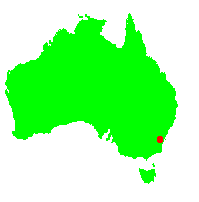General Description:
The genus Telopea contains five species all confined to east coast regions from northern New South Wales to Tasmania. The most famous species is Telopea speciosissima, the New South Wales’ waratah, which has been in cultivation since the first years of European settlement in Australia. The other four members of the genus would undoubtedly be more widely known and grown were it not for their illustrious relative. Indeed, the three southern species have all been given Awards Of Merit by the Royal Horticultural Society in the first half of the 20th Century (the fourth, Telopea aspera, or Gibraltar Range waratah, was split off as a separate species from the NSW waratah.
Telopea mongaensis is a multi-stemmed shrub to about 6 metres in height. Like its better known relative, it has an underground lignotuber from which regeneration of the plant can occur after bushfires. The species has dark green, narrowly obovate leaves up to 18 cm long. The flower clusters are terminal, occurring as flattened heads of a compact cluster of up to 65 individual red flowers. Like the very similar T.oreades, the inflorescences lack the conspicuous and colourful bracts of T.speciosissima. Flowering occurs in spring.
Based on limited experience, T.mongaensis seems to be the reasonably adaptable to cultivation and well established plants have been observed at the National Botanic Gardens (Canberra) and at the Mount Tomah Botanic Garden (New South Wales). However, it is not commonly available through nurseries and its adaptability to a wide range of climates is not known. The plant requires good drainage with ample moisture and is tolerant of moderate shade. The cultivar ‘Braidwood Brilliant” is a hybrid between T.mongaensis and T.speciosissima.
Propagation is best from seed which should germinate within 4-6 weeks if it is viable. No special pretreatment is necessary but seedlings are susceptible to damping off (a fungal disease) and need to be kept under observation. Cuttings can be slow to strike.
* EPBC Act = Environment Protection and Biodiversity Conservation Act 1999;
ROTAP = Rare or Threatened Australian Plants (Briggs and Leigh, 1988)
For further information refer the Australian Plants at Risk page

Telopea mongaensis
Photo: Brian Walters
 Australian Native Plants Society (Australia)
Australian Native Plants Society (Australia)